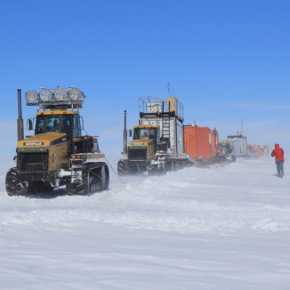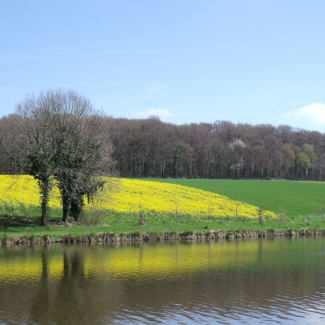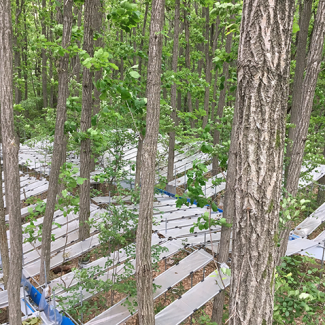
Expedition on Antarctic plateau to better gauge sea level rise
From 7 December 2019 to 25 January 2020, a team of scientists from France (CNRS and Université Grenoble Alpes) and Italy (Consiglio Nazionale delle Ricerche, Istituto Nazionale Geofisica e Vulcanologia) will traverse the middle of the Antarctic plateau, travelling 1,318 km, round trip, from the Franco-Italian Concordia research station towards the south pole and back. The expedition, dubbed the East Antarctic International Ice Sheet Traverse (EAIIST), is coordinated by the French Polar Institute, in collaboration with the Italian National Antarctic Programme, and backed by the French National Research Agency and the BNP Paribas Foundation. The two main goals of the EAIIST expedition are to acquire a deeper understanding of the climate ‘archives’ encoded in ice cores and more accurately predict the rise in sea levels.
How the Antarctic continent is reacting to current global warming is one of the greatest unknowns related to climate change. We are already seeing greater melting of the ice sheet, especially along the coast. Yet some models suggest that warming is matched by more intense precipitation on the snowy continent, which would limit the loss in ice sheet mass and offset rising sea levels.
French, Italian, and Australian scientists want to test this hypothesis by determining whether more snow has indeed accumulated on the Antarctic plateau. To do so, the EAIIST expedition will explore those regions of the plateau that are the most arid, inhospitable, and poorly understood,1 though nonetheless essential to the functioning of the planetary climate system.
In the region targeted by the expedition, halfway between Concordia and the south pole, hyperarid conditions and wind patterns have formed landscapes found nowhere else on our planet: areas of bare ice as well as megadunes, whose vast scale makes them only apparent by satellite. Understanding their formation and how they record atmospheric composition is essential to interpreting the ice cores, which serve as natural archives of past climate data. This region is considered one of the best models of glacial periods,2 when rates of precipitation were much lower than during warmer intervals.
Together the EAIIST crew members boast a range of pertinent areas of expertise: snow physics, geophysics, geochemistry, atmospheric chemistry, and meteorology. At the various stages of the expedition, these specialists will be taking snow samples and extracting ice cores; performing radar profiles of stacked snow layers; and installing GPS, seismic, and weather stations to record data on ice behaviour and precipitation from season to season at the different sites visited. Field measurements will be compared with satellite data and followed up by laboratory studies.
The completely autonomous EAIIST expedition also poses a logistic challenge. In 50 days, its 243-t convoy will be travelling 1,318 km (nearly 4,000 km if you count the preliminary leg starting on the coast) at an average speed of 8 km/h and ‘summery’ temperatures ranging from −25 to −45 °C. This is only possible with French Polar Institute and Italian National Antarctic Programme know-how and experience, and support from the Australian Antarctic Division. The permanent crew of ten will include three logisticians and a doctor specialized in emergency medicine, all four of whom are affiliated with these polar research agencies.
The project is jointly led by Barbara Stenni, from Ca' Foscari University of Venice, and Joël Savarino, CNRS researcher at the Institute of Environmental Geosciences (CNRS / Université Grenoble Alpes / IRD / Grenoble INP) and science coordinator on the traverse. In all, it involves roughly forty-some scientists (affiliated with over a dozen research laboratories in France, Italy, and Australia), including the expedition crew.
In addition to funds going to staff salaries and logistical support (over a million euros), the scientific operation has received 1.6 million euros from the ANR and the BNP Paribas Foundation. The Italian component of the EAIIST project is funded by Italy’s education and research ministry (MIUR), through the PNRA.
Find out more about the expedition and track its progress
Web: www.eaiist.com | Facebook: EAIIST Traverse | Twitter: @eaiist
Visual assets
A short film by the French Polar Institute: https://vimeo.com/377102990 [in French. English available soon]
Pictures are available from the CNRS photo library: phototheque.cnrs.fr/p/786-1-1-0
Left: ASUMA expedition caravan. The EAIIST convoy will include a snow mover and five large track tractors pulling containers on sleds. The containers will house warm and cold laboratories and living quarters, in addition to holding scientific instruments, ice cores, and fuel reserves.
Right: surface drilling (50−100 m) through hatch in floor of mobile cold laboratory. In the arid expanses of eastern Antarctica, such depths yield data on events a thousand years ago.
© Bruno Jourdain / IGE / CNRS Photo Library


